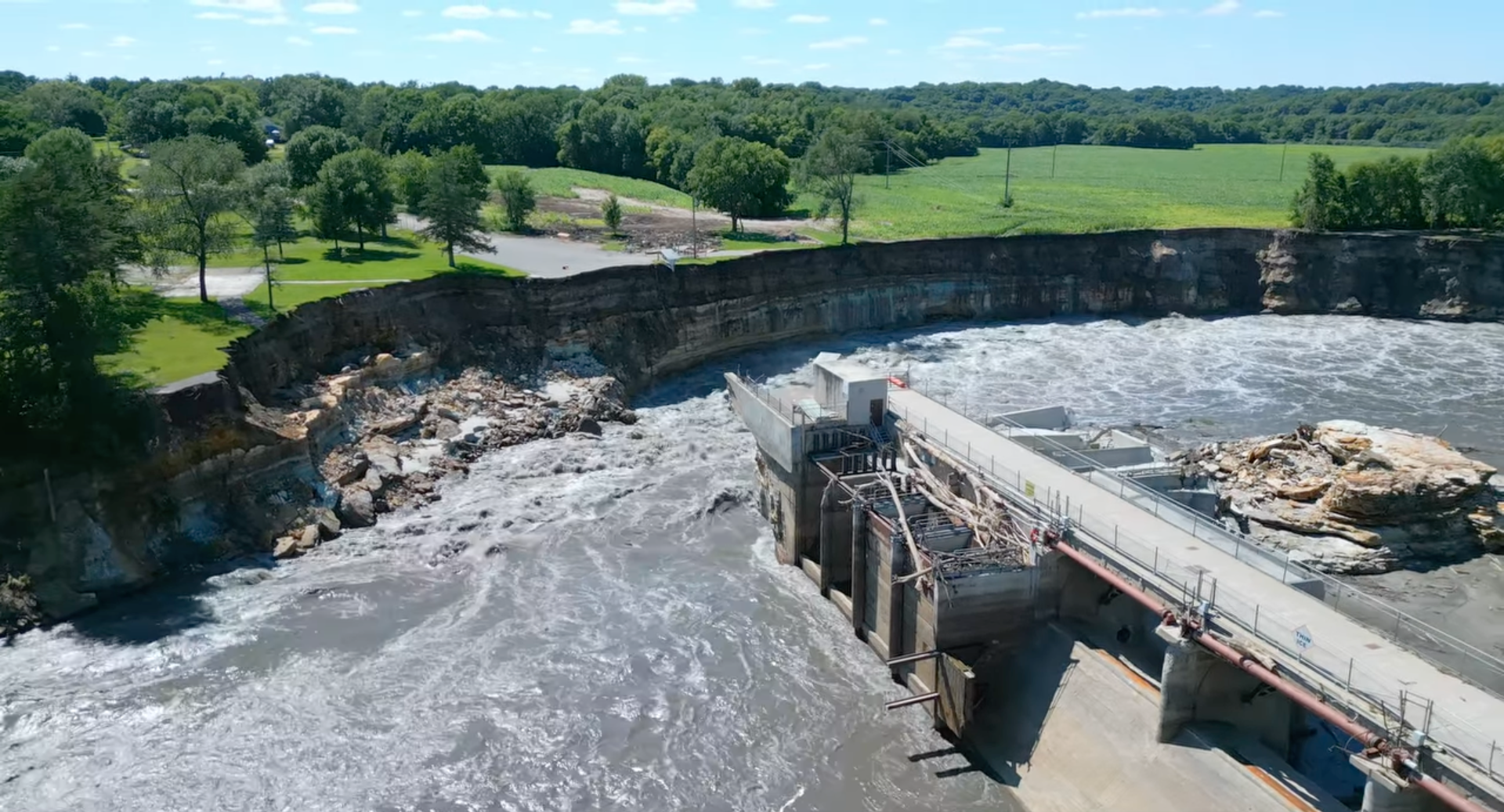Q & A: What the Rapidan Dam has us thinking about aging locks and dams in the Twin Cities

This year's intense rains and flooding led to the partial failure of the Rapidan Dam. (Photo from AW Aerial; used with permission)
The show of destructive power at the Rapidan Dam near Mankato in June was impossible to ignore. The Blue Earth River's roaring water overwhelmed the century-old structure, tearing a gash through the river's bank.
FMR staff joined the many Minnesotans worried for the families and community members affected by such loss.
We also worried that this kind of disaster could easily repeat elsewhere in the future. FMR Executive Director Whitney Clark spoke to the Washington Post about related national concerns. I asked Land Use & Planning Program Director Colleen O'Connor Toberman to help us understand any parallels between the Rapidan Dam and the locks and dams on the Mississippi River in the heart of the Twin Cities.
Ellie: Like many people, you were closely watching updates from the Rapidan Dam as it threatened to collapse. What were you thinking as you saw the footage and news?
Colleen: I wasn't surprised. While the news footage from Rapidan was especially dramatic, this same story is playing out here in the Twin Cities and all over the country. Obsolete, deteriorating dams are sitting in rivers without clear plans to repair or remove them in any timely manner.
When we don't act, nature will eventually take over. It's inevitable.
Ellie: Blue Earth County, the owner of the Rapidan Dam, was in the process of trying to decide what to do with this hundred-year-old structure. Where are we at with the Twin Cities' three locks and dams on the Mississippi River?
Colleen: Our locks and dams here in the metro have an uncertain future, too. Congress ordered the closure of the Upper St. Anthony Falls Lock in Minneapolis 10 years ago, rendering the downstream locks and dams (Lower St. Anthony Falls and Lock and Dam 1) obsolete. But 10 years later, the Army Corps still hasn't finished any of the disposition studies needed to make long-term decisions about maintaining or removing the dams.
Over those 10 years, we've seen the structures deteriorate as maintenance investments are minimized. We don't know whether this is creating any safety hazards yet. But we know we can't afford to keep waiting forever for these disposition decisions to be made.
We need a thorough process with good engagement, but right now, the studies are moving so slowly that we can't even get the information that the community needs to weigh the options.
Ellie: The breach in the Rapidan Dam set loose "more than a century's-worth of sediment pollution" to wash downstream. Tons of sediment have built up behind our Twin Cities dams as well. How would intentional dam removal deal with all that sediment?
Colleen: Per the Army Corps, there might be 3 million cubic meters of sediment piled up behind Lock and Dam 1 in St. Paul, some of it contaminated with heavy metals and other substances we don't want washing downstream. This sediment would likely need to be slowly removed, treated and properly landfilled as part of a dam removal process.
The cost of sediment removal is one of the reasons why the Rapidan Dam was left to deteriorate in the river. Unfortunately, now that sediment is washing into Blue Earth, Minnesota, and eventually the Mississippi rivers in a completely uncontrolled manner with no remediation measures in place.
Ellie: We've been talking about locks and dams, but can you tell us more about the state of the underground wall holding up St. Anthony Falls and how floodwaters might impact its integrity?
Colleen: We don't know, which is very concerning. The sandstone geology around St. Anthony Falls is in some ways similar to that at the Rapidan Dam. We see how fragile that can be.
The good news is that a major study of this cutoff wall is underway, thanks to FMR's advocacy, River Guardians and Minnesota lawmakers.
Ellie: What does this year's flood and its aftermath drive home for you?
Colleen: Decisions about what to do with these old dams are hard to make, not to mention expensive. It's tempting to put them off for as long as we can.
But as we look towards a future with more extreme climate change-induced rainfall and flooding, these aging structures will only become more hazardous. We can't afford to wait for long to decide what to do with them.
Become a River Guardian
Sign up and we'll email you when important river issues arise. We make it quick and easy to contact decision-makers. River Guardians are also invited to special social hours and other events about legislative and metro river corridor issues.